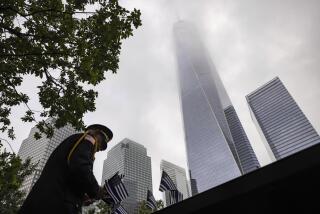Deck stacked against 9/11 cards
- Share via
Card No. 53 tells the story of James DeBlase, a middle-aged stockbroker with a love for football. No. 60 describes Yvette Anderson, a religious woman who enjoyed cooking collard greens. And No. 73 speaks of Dan Heg- lund, a dedicated New York City firefighter captain. DeBlase, Anderson and Heglund, all of whom died in the terrorist attacks on Sept. 11, are now part of “The Heroes of the World Trade Center,” a set of 202 palm-sized cards commemorating the events of that infamous day. Similar to baseball trading cards, each has a photo displaying a victim or topic on the front, with biographies and descriptions of 9/11-related events featured on the back.
Kingsley Barham, creator of the cards, said his goal for “Heroes” is to put a human face on a national tragedy. However, not everyone is seeing things in that light. Stephen Push, who lost his wife when her plane crashed into the Pentagon, thinks the idea of is tasteless.
“I think he is doing it for the money. He wants the publicity,” Push, a member of Families of 9/11, said of Barham’s decision to publish the cards. “It’s not the way I would want to memorialize my wife. It seems commercial.” Push is not the only one to object to the cards. New York Mayor Michael Bloomberg, who is featured on his own “Heroes” card, told the New York Post that the cards were “sick” and “despicable.” He also said Barham is “cashing in on the city’s worst tragedy.”
“More than 150 books have been written on the subject of 9/11. No one ever asked them if they wrote the books for the money. So why are people asking me?” responded Barham, president of Chestnut Publications, based in Delray Beach, Fla. Barham insists that the cards, depicting 160 people and 42 subjects (ranging from anthrax to pollution), should be viewed as a memorial, depicting both living and deceased civilians who left their mark on the world that day. The cards are packed in an eight-card foil pack, with a retail price of $2.50. An 8% royalty from the gross sales of the cards will go to families who allowed loved ones to be featured on the cards.
Barham said that victims’ families were contacted about the cards and that those who refused to participate were left out. He let each family decide how to describe the relative pictured.
“They are not meant to be trading cards. They are only to be collected,” Barham said. “The only reason these cards are controversial is because of the medium in which they are presented. They are not baseball cards. They are just the same size.” The cards are due to arrive in retail stores early next year, but they currently can be found in some comic-book and specialty stores.


